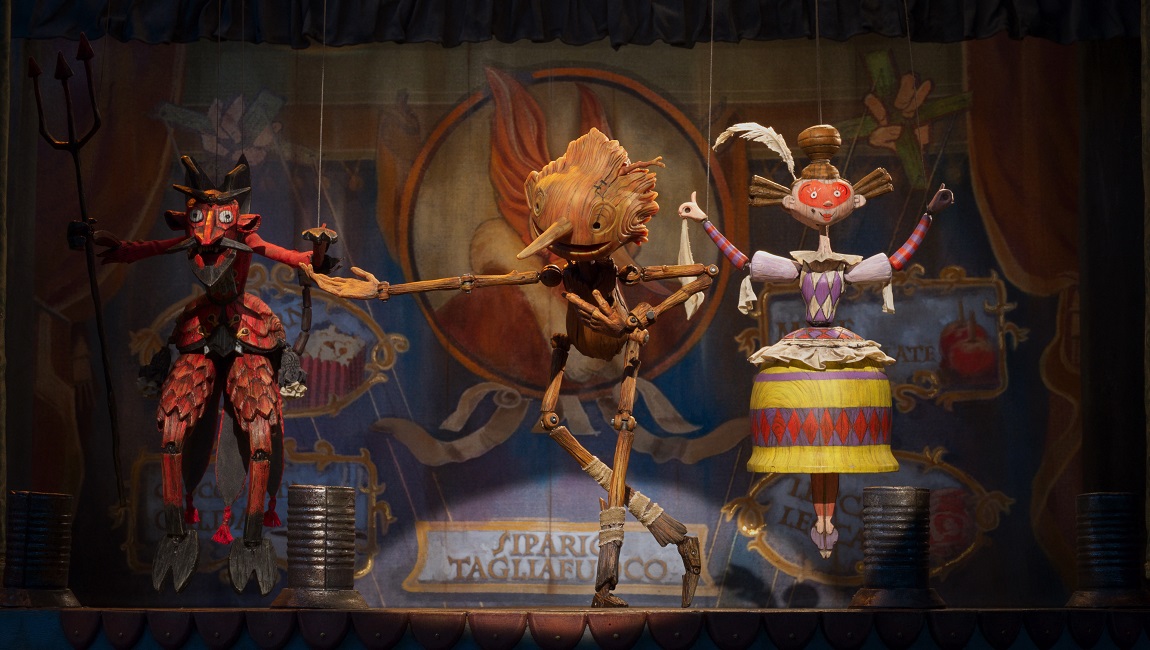Guillermo del Toro’s Pinocchio takes its well-worn titular tale and manages to make it feel fresh, despite a few incoherencies along the way.
In what seems to be something of a victory lap, after winning that most coveted Oscar for The Shape of Water, it might seem to be a predictable move for director Guillermo del Toro to at last produce his 14-year fairy tale passion project. Less predictable is just how fearless and refreshing the project has turned out to be. To adapt such a well-known, endlessly-reproduced story (to wit: we just had Robert Zemeckis’ version a short three months ago) invites obvious criticisms — of veering too far from the path, or conversely of maintaining its course too rigidly — and after Disney’s aforementioned disastrous live-action adaptation earlier this autumn, the potential pitfalls of such an endeavor have never been more apparent. But instead of proving deferential to the original story’s considerable influence and tradition, Guillermo del Toro’s Pinocchio runs headfirst at its source material, simultaneously venerating and challenging its very history.
The bare bones of the story remain the same: A grieving carpenter creates a wooden puppet, Pinocchio, a boy with a nose that grows when he lies, to replace the son he has lost, only for the puppet to come to life, dreaming of one day becoming a real boy. As Pinocchio ventures into the real world, he meets those who would exploit him, but is protected by his obedience to his father. In a 2011 interview with TIME, del Toro describes two types of fairytale: “One is pro-institution, which is the most reprehensible type of fairy tale: Don’t wander into the woods, and always obey your parents. The other type of fairy tale is completely anarchic and anti-establishment”. In adapting Pinocchio, del Toro and co-director Mark Gustafson take a story that is, by design, situated firmly in the former camp, extolling the virtues of obedience, and transplant it to the era most likely to challenge its core tenet: the fascist climate of 1930s Europe. As in his earlier works, Pan’s Labyrinth and The Devil’s Backbone particularly — del Toro’s magical-realist aesthetic sensibility is indivisible from his anti-fascist ethos, confronting the flaws in his source material and massaging them with love, crafting a story that actually challenges and enhances its source material. In an era of endless reboots and slavish devotion to rehashing old stories, Guillermo del Toro’s Pinocchio refuses the lure of passive adaptation, instead wrestling tradition into submission and constructing something that, despite being nearly a century and a half old at this point, feels distinctly alert to the world we live in.
But for all the passion clearly built into this project, there are a few notable places where del Toro’s striking vision fails to entirely cohere. His marriage of magical realist design instincts and the brutality of fascist history blends with stunning effect visually, but on the page the two parts don’t coalesce as elegantly — what some might regard as intentionally stark contrasts instead can feel more like exposed seams, the unavoidable marks of two wholly different sensibilities imperfectly melded. Similarly, Pinocchio‘s musical numbers, few and far between though they may be, are among the film’s more forgettable elements, failing to keep pace with the astonishing stop-motion visuals punctuating its frames. Still, such flaws land with only minor impact, and none take too much away from what del Toro and Gustafson have achieved: a vivid, warm, and, most importantly, new adaptation of a tale pocked with the potential to feel tired and dated.
You can stream Guillermo del Toro & Mark Gustafson’s Pinocchio on Netflix beginning on December 9.







